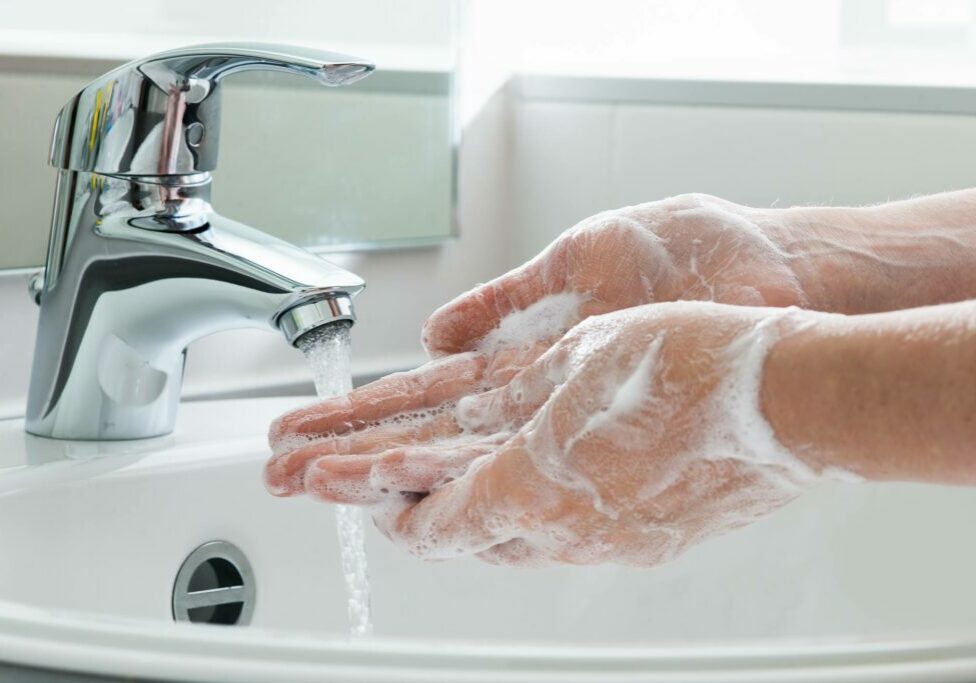Published in the December 2014 NJEA Review
By Frances Gilmore
Taking the correct precautions will minimize the spread of both airborne and bloodborne infections.
Note: If you have read this article in the NJEA Review and are seeking the additional information and resources referenced there, scroll to the end of this article.
In this year’s cold and flu season, the most common strain of virus was Enterovirus D68 (EV-D68), which hit children hardest, especially those with asthma or other respiratory conditions. Children have been hospitalized in most states with severe respiratory illness, and a 5-year-old child died of the virus in New Jersey.
By the end of fall, enterovirus infections are expected to taper off. At about the same time, respiratory illnesses caused by other viruses, like influenza and respiratory syncytial virus (RSV), will become more common. So it is wise to be aware of appropriate precautions.
How airborne and bloodborne infections are spread
Since EV-D68 causes respiratory illness, it can be found in an infected person’s respiratory secretions, such as saliva, nasal mucus, or sputum. EV-D68 and other airborne illnesses such as strep throat, likely spread from person to person when an infected person coughs or sneezes, and the virus becomes aerosolized and is inhaled by others. Infection can also spread by close contact with an infected person, and by touching surfaces or objects with virus on them, and then touching one’s eyes, nose, or mouth with unwashed hands.
Bloodborne illnesses, such as hepatitis B, hepatitis C and measles, can be transmitted by direct contact of eyes, nose, mouth or broken skin with an infected person’s bodily fluids. Contact may occur when treating a nosebleed or wound or cleaning up vomit or other bodily fluid, or cutting yourself with a needle or broken glass with bodily fluid on it.
Appropriate precautions for airborne and bloodborne illness
Certain basic precautions apply to both airborne and bloodborne illnesses.
- Washing hands correctly is the most important thing you can do to stay healthy. Wash hands often with soap and water for 20 seconds. Wash all surfaces well, including wrists, palms, backs of hands, fingers and under nails. Clean dirt from under nails
- Avoid touching eyes, nose and mouth with unwashed hands.
- Avoid close contact and sharing eating utensils with people who are sick.
- Cover coughs and sneezes with a tissue or shirt sleeve, not your hands.
- Clean and disinfect frequently-touched or contaminated surfaces, such as toys, doorknobs and faucets (see box for details).
- Staff and students should stay home when they are sick and return only 24 hours after fever is gone.
A note to nurses: Children with asthma should be sure to take their medications, and may need to consult their doctors to revise their asthma management plan. The Centers for Disease Control also advises them to get a flu shot.
Key requirements of the PEOSH Bloodborne Pathogen Standard
- Universal precautions: Handle all human blood and other bodily fluids as if they were contaminated.
- Personal protective equipment (PPE): When cleaning contaminated surfaces or assisting a person whose blood or other bodily fluids are present, use gloves, and other PPE as needed, such as goggles or lab coats.
- Engineering controls: Whenever possible, use methods that contain or remove the hazard, such as puncture-resistant containers for sharps.
- Standard procedures: Hand washing and written procedures must be in place for regular cleaning of the school and cleaning, sanitizing and disinfecting potentially contaminated surfaces.
- Vaccination: The hepatitis B vaccine must be offered at no cost to covered employees within 10 days after beginning their jobs.
Strengthening compliance with the PEOSH BBP standard
Further measures are needed to protect against bloodborne diseases. These measures are contained in the Public Employees Occupational Safety and Health Bloodborne Pathogen (PEOSH BBP) Standard, in place since 1993.
Local associations should work with their UniServ field representatives to ensure that a written plan is in place, enforced, and meets the requirements of the standard. Because details of compliance are up to individual school districts, local associations should seek strong protections, including:
- Ensuring that coverage applies broadly, not just to those whose written job descriptions include potential exposure. People potentially at risk include nurses, custodians, athletic directors, cafeteria workers, bus drivers, and teachers who may clean surfaces in their work areas.
- Prompt evaluation and medical follow-up for potentially exposed employees.
- A strong post-exposure plan, reviewed annually by, for example, the health and safety committee, association members, including school nurses, and district administration.
Cleaning, sanitizing and disinfecting surfaces safely
There are three levels of surface decontamination:
- Cleaning physically removes dirt and microorganisms, by scrubbing with water and soap or detergent, followed by rinsing. It is sufficient for most areas of a school, including desks, tables, chairs and floors.
- Sanitizing kills some microorganisms, and is recommended for food preparation and service areas, and toilet and diapering areas. Following cleaning, apply a sanitizer, commonly a solution of 1/4 cup household bleach per gallon of water.
- Disinfecting kills many microorganisms, and is needed to clean up areas heavily contaminated with bodily fluids, such as blood or vomit. After cleaning, use 1.5 cups household bleach per gallon of water. Thoroughly douse contaminated area and let stand for three minutes. If you use a spray bottle, put in on “jet” mode rather than “aerosol,” to avoid creating a toxic mist. Wipe the surface with paper towels and discard the towels. Make a fresh bleach solution daily.
Local associations should strive to put in place healthy cleaning policies, including an approved list of certified, least toxic products; training for custodians, bus drivers and others who clean surfaces, in cleaning protocols, chemical product hazards; handling, measuring, mixing and storing, and protective equipment. See the first information resource on the list below for more details.
